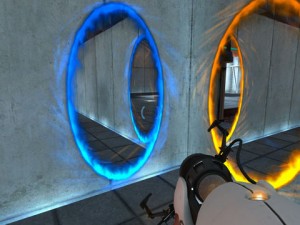Hello once again, faithful readers! Today, I bring a review of Portal For those living under a rock, Portal is a Valve game, released in 2007 for PC, Xbox 360, and PS3. Portal was also released as part of The Orange Box, along with Team Fortress 2 and the collection of the Half-Life 2 episodes. Though short, Portal received critical acclaim for its creative gameplay and its unique writing. Does the popular Valve game live up to its hype? Read on, and find out!
The gameplay of Portal is based, unsurprisingly, on the use of portals. The player is eventually given control over two linked portals, which are used to solve various puzzles and proceed through the game’s setting. The portal mechanics provide an interesting and unique game experience; portals are used to get around obstacles, redirect balls of energy, and even fling the player character across gaps. Portal, like nearly all Valve games, uses a first-person gameplay perspective to create a more immersive experience.

This is an illustration of how momentum is conserved in a portal and can be used to fling Chell across gaps.
Portal also uses its setting and narrative to great effect. The player takes the role of Chell, a test subject for a group named Aperture Science. Very little is otherwise known about Chell, as she is given no lines and almost no backstory. Chell must make her way through various test chambers using her portal gun. She is overseen by the artificially intelligent GlaDOS, whose witty commentary provides the vast majority of the game’s narrative. GlaDOS alternates frequently between being a caring, if robotic, being, and hilarious sarcasm that greatly adds to the Portalexperience. The Aperture Science lab is austere and empty; Chell is apparently the only remaining human in the laboratory setting. The setting and narrative of Portal are brilliant, the writing excellent, and the character of GlaDOS spectacular.
Musically speaking, Portal is somewhat limited. Most of the game has no backing music, though during particularly stressful or tense sections of the game, fitting music will play to increase the player’s tension. Portal also famously has “Still Alive”, a catchy song sung by GlaDOS during the game’s credit sequence. Other than “Still Alive”, Portal has very little music, and there is therefore little to say about the game’s soundtrack. Graphically, Portal is excellent. The game looks fantastic, and the graphics greatly contribute to the Portal atmosphere. As a reviewer who rarely pays graphics any mind, even I must admit Portal is an amazing looking game. The orange and blue portals greatly stand out against the whites and grays of the Aperture Science test chambers, and it is never difficult to see where the player’s portals have ended up. Additionally, one can see through a portal to the other side, which, while confusing, is also logical and increases the immersion of the gaming experience. While graphics do not often greatly affect the immersion of a game’s experience, the graphics in Portal are the final quality needed to create an excellent experience.
Does Portal live up to the hype? The answer is a resounding yes. Though short (only about five or six hours for the first playthrough), Portal is completely worth the $10 Steam purchase. Better yet, readers, buy The Orange Box, which is only 20 dollars on Steam at the moment, or even the $99.99 Valve Complete Collection, and get all of Valve’s releases at a massive discount. Portal, whether by itself or part of a bundle, should be a part of any gamer’s collection, and I strongly urge any reader or staff member who has not done so to purchase Portal at once. Portal is available for PC and Mac as a disc or through Steam, as well as the Xbox 360 and the PS3 as a standalone game and as part of The Orange Box

